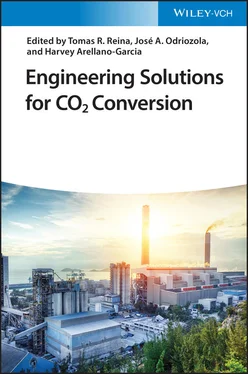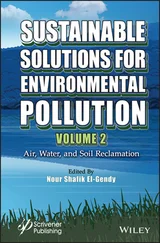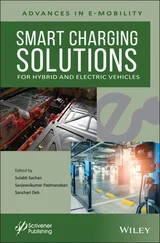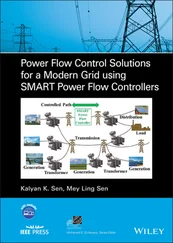32 32 Gu, F., Liu, C.J., Yuan, X.G., and Yu, G.C. (2004). CFD simulation of liquid film flow on inclined plates. Chem. Eng. Technol. 27: 1099–1104.
33 33 Valluri, P., Matar, O.M., Hewitt, G.F., and Mendes, M.A. (2005). Thin film flow over structured packings at moderate Reynolds numbers. Chem. Eng. Sci. 60 (7): 1965–1975.
34 34 Ataki, A. and Bart, H.J. (2006). Experimental and CFD simulation study for the wetting of a structured packing element. Chem. Eng. Technol. 29 (3): 336–347.
35 35 Haroun, Y., Raynal, L., and Legendre, D. (2012). Mass transfer and liquid hold‐up determination in structured packing by CFD. Chem. Eng. Sci. 75: 342–348.
36 36 Iso, Y., Huang, J., Kato, M. et al. (2013). Numerical and experimental study on liquid film flows on packing elements in absorbers for post‐combustion CO2 capture. Energy Procedia 37: 860–868.
37 37 Sebastia‐Saez, D., Reina, T.R., and Arellano‐Garcia, H. (2017). Numerical modelling of braiding and meandering instabilities in gravity‐driven liquid rivulets. Chem. Ing. Tech. 89 (11): 1515–1522.
38 38 Sun, H., Wu, C., Shen, B. et al. (2018). Progress in the development and application of CaO‐based adsorbents for CO2 capture – a review. Mater. Today Sustainability1–2: 1–27.
39 39 Atsonios, K., Zeneli, M., Nikolopoulos, A. et al. (2015). Calcium looping process simulation based on an advanced thermodynamic model combined with CFD analysis. Fuel 153: 370.
40 40 Abbasi, E., Abbasian, J., and Arastoopour, H. (2015). CFD‐PBE numerical simulation of CO2 capture using MgO‐based sorbent. Powder Technol. 286: 616–628.
41 41 Ryan, E.M., DeCroix, D., Breault, R. et al. (2013). Multi‐phase CFD modeling of solid sorbent carbon capture system. Powder Technol. 242: 117–134.
42 42 Barelli, L., Bidini, G., and Gallorini, F. (2016). CO2 capture with solid sorbent: CFD modelling of an innovative reactor concept. Appl. Energy 162: 58–67.
43 43 Sornumpol, R., Uraisakul, W., Kuchonthara, P. et al. (2017). CFD simulation of fuel reactor in chemical looping combustion. Energy Procedia 138: 979–984.
44 44 Kim, M., Na, J., Park, S. et al. (2018). Modeling and validation of a pilot‐scale aqueous mineral carbonation reactor for carbon capture using computational fluid dynamics. Chem. Eng. Sci. 177: 301–312.
45 45 Chen, Q., Rosner, F., Rao, A. et al. (2019). Simulation of elevated temperature solid sorbent CO2 capture for pre‐combustion applications using computational fluid dynamics. Appl. Energy 237: 314–325.
46 46 Ghadirian, E., Abbasian, J., and Arastoopour, H. (2019). CFD simulation of gas and particle flow and a carbon capture process using a circulating fluidized bed (CFB) reacting loop. Powder Technol. 344: 27–35.
47 47 Wang, S., Hu, B., Jin, C. et al. (2019). Dense discrete phase model simulations of CO2 capture process in a fluidized bed absorber with potassium‐based solid sorbent. Powder Technol. 345: 260–266.
48 48 Wu, F., Argyle, M.D., Dellenback, P.A., and Fan, M. (2018). Progress in O2 separation for oxy‐fuel combustion–a promising way for cost‐effective CO2 capture: a review. Prog. Energy Combust. Sci. 67: 188–205.
49 49 Wu, Y., Liu, D., Duan, L. et al. (2018). Three‐dimensional CFD simulation of oxy‐fuel combustion in a circulating fluidized bed with warm flue gas recycle. Fuel 216: 596–611.
50 50 Bhuiyan, A.A. and Naser, J. (2015). CFD modelling of co‐firing of biomass with coal under oxy‐fuel combustion in a large scale power plant. Fuel 159: 150–168.
51 51 Gharebaghi, M., Irons, M.R.A., Ma, L. et al. (2011). Large eddy simulation of oxy‐coal combustion in an industrial combustion test facility. Int. J. Greenhouse Gas Control5S1: S100–S110.
52 52 Mayr, B., Prieler, R., Demuth, M. et al. (2015). CFD and experimental analysis of a 115 kW natural gas fired lab‐scale furnace under oxy‐fuel and air‐fuel conditions. Fuel 159: 864–875.
53 53 Carrasco‐Maldonado, F., Bakken, J., Ditaranto, M. et al. (2017). Oxy‐fuel burner investigations for CO2 capture in cement plants. Energy Procedia 120: 120–125.
54 54 Edge, P.J., Heggs, P.J., Pourkashanian, M., and Stephenson, P.L. (2013). Integrated fluid dynamics‐process modelling of a coal‐fired power plant with carbon capture. Appl. Therm. Eng. 60: 456–464.
55 55 Fei, Y., Black, S., Szuhánszki, J. et al. (2015). Evaluation of the potential of retrofitting a coal power plant to oxi‐firing using CFD and process co‐simulation. Fuel Process. Technol. 131: 45–58.
56 56 He, D., Jiang, P., Lun, Z. et al. (2018). Pore scale CFD simulation of supercritical carbon dioxide drainage process in porous media saturated with water. Energy Sources Part A https://doi.org/10.1080/15567036.2018.1549155.
57 57 Dezfully, M.G., Jafari, A., and Gharibshahi, R. (2015). CFD simulation of enhanced oil recovery using nanosilica/supercritical CO2. Adv. Mater. Res. 1104: 81–86.
58 58 Gharibshahi, R., Jafari, A., and Ahmadi, H. (2019). CFD investigation of enhanced extra‐heavy oil recovery using metallic nanoparticles/steam injection in a micromodel with random pore distribution. J. Pet. Sci. Eng. 174: 374–383.
59 59 Engelbrecht, N., Chiuta, S., Everson, R.C. et al. (2017). Experimentation and CFD modelling of a microchannel reactor for carbon dioxide methanation. Chem. Eng. J. 313: 847–857.
60 60 Ohya, H., Fun, J., Kawamura, H. et al. (1997). Methanation of carbon dioxide by using membrane reactor integrated with water vapor permselective membrane and its analysis. J. Membr. Sci. 131: 237–247.
61 61 Alarcón, A., Guilera, J., and Andreu, T. (2018). CO2 conversion to synthetic natural gas: reactor design over Ni–Ce/Al2O3 catalyst. Chem. Eng. Res. Des. 140: 155–165.
62 62 Kopyscinski, J., Schildhauer, T.J., Vogel, F. et al. (2010). Applying spatially resolved concentration and temperature measurements in a catalytic plate reactor for the kinetic study of CO methanation. J. Catal. 271: 262–279.
63 63 Kopyscinski, J., Schildhauer, T.J., and Biollaz, S.M.A. (2011). Fluidized‐bed methanation: interaction between kinetics and mass transfer. Ind. Eng. Chem. Res. 50: 2781–2790.
64 64 Sun, L., Luo, K., and Fan, J. (2017). Numerical simulation of CO methanation for the production of synthetic natural gas in a fluidized bed reactor. Energy Fuels 31: 10267–10273.
65 65 Wu, C. and Tian, D. (2010). CFD‐DEM simulation of syngas to methane process in a fluidized bed reactor. The 13th International Conference on Fluidization – New Paradigm in Fluidization Engineering, 16–21 May 2010 – Hotel Hyundai, Gyeong‐ju, Korea.
66 66 Chatterjee, S. (2017). CFD analysis on hydrodynamic conditions of a designed spiral column photobioreactor for cultivation of microalgae. World J. Eng. 14 (5): 443–450.
67 67 Zitney, S.E. (2010). Process/equipment co‐simulation for design and analysis of advanced energy systems. Comput. Chem. Eng. 34: 1532–1542.
68 68 Lang, Y., Zitney, S.E., and Biegler, L.T. (2011). Optimization of IGCC processes with reduced order CFD models. Comput. Chem. Eng. 35: 1705–1717.
69 69 Rönsch, S., Schneider, J., Matthischke, S. et al. (2016). Review on methanation – from fundamentals to current projects. Fuel 166: 276–296.
3 Membranes Technologies for Efficient CO 2Capture–Conversion
Sonia Remiro‐Buenamañana, Laura Navarrete, Julio García‐Fayos, Sara Escorihuela, Sonia Escolástico, and José M. Serra
Instituto de Tecnología Química (Universitat Politècnica de València‐Consejo Superior de Investigaciones Científicas), Av. de los Naranjos s/n, Valencia, E‐46022, Spain
The growing interest of the scientific community toward global warming and its consequences over environment has led to investigate new energy resources in order to decrease the dependence on fossil fuels. Combustion processes, mainly represented by power generation and industry sectors, account for more than 50% of CO 2emissions, increasing at a rate of 2.5 per year with a worldwide amount of 33.1 GtCO 2during 2018 [1]. Therefore, these processes are the main source of the total CO 2emitted to the atmosphere. As part of the greenhouse effect mitigation, efforts have been made toward decreasing these atmospheric CO 2emissions. The most considered actions are to capture the CO 2from point source emissions [2] and to use it as a feedstock to valuable chemicals and fuels [3].
Читать дальше












